engine MAZDA MODEL RX 8 2006 (in English) Manual PDF
[x] Cancel search | Manufacturer: MAZDA, Model Year: 2006, Model line: MODEL RX 8, Model: MAZDA MODEL RX 8 2006Pages: 434
Page 264 of 434
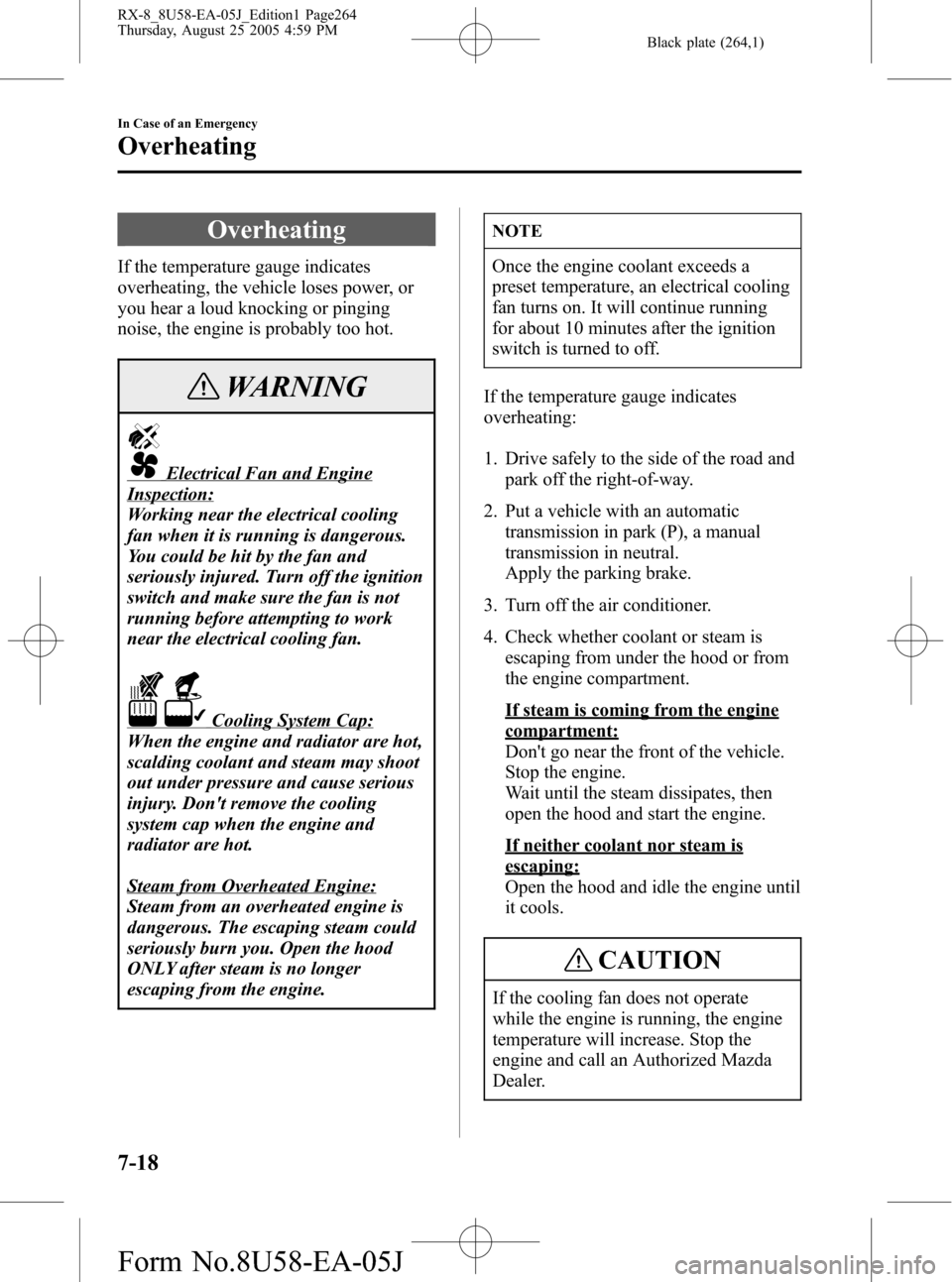
Black plate (264,1)
Overheating
If the temperature gauge indicates
overheating, the vehicle loses power, or
you hear a loud knocking or pinging
noise, the engine is probably too hot.
WARNING
Electrical Fan and Engine
Inspection:
Working near the electrical cooling
fan when it is running is dangerous.
You could be hit by the fan and
seriously injured. Turn off the ignition
switch and make sure the fan is not
running before attempting to work
near the electrical cooling fan.
Cooling System Cap:
When the engine and radiator are hot,
scalding coolant and steam may shoot
out under pressure and cause serious
injury. Don't remove the cooling
system cap when the engine and
radiator are hot.
Steam from Overheated Engine:
Steam from an overheated engine is
dangerous. The escaping steam could
seriously burn you. Open the hood
ONLY after steam is no longer
escaping from the engine.
NOTE
Once the engine coolant exceeds a
preset temperature, an electrical cooling
fan turns on. It will continue running
for about 10 minutes after the ignition
switch is turned to off.
If the temperature gauge indicates
overheating:
1. Drive safely to the side of the road and
park off the right-of-way.
2. Put a vehicle with an automatic
transmission in park (P), a manual
transmission in neutral.
Apply the parking brake.
3. Turn off the air conditioner.
4. Check whether coolant or steam is
escaping from under the hood or from
the engine compartment.
If steam is coming from the engine
compartment:
Don't go near the front of the vehicle.
Stop the engine.
Wait until the steam dissipates, then
open the hood and start the engine.
If neither coolant nor steam is
escaping:
Open the hood and idle the engine until
it cools.
CAUTION
If the cooling fan does not operate
while the engine is running, the engine
temperature will increase. Stop the
engine and call an Authorized Mazda
Dealer.
7-18
In Case of an Emergency
Overheating
RX-8_8U58-EA-05J_Edition1 Page264
Thursday, August 25 2005 4:59 PM
Form No.8U58-EA-05J
Page 265 of 434
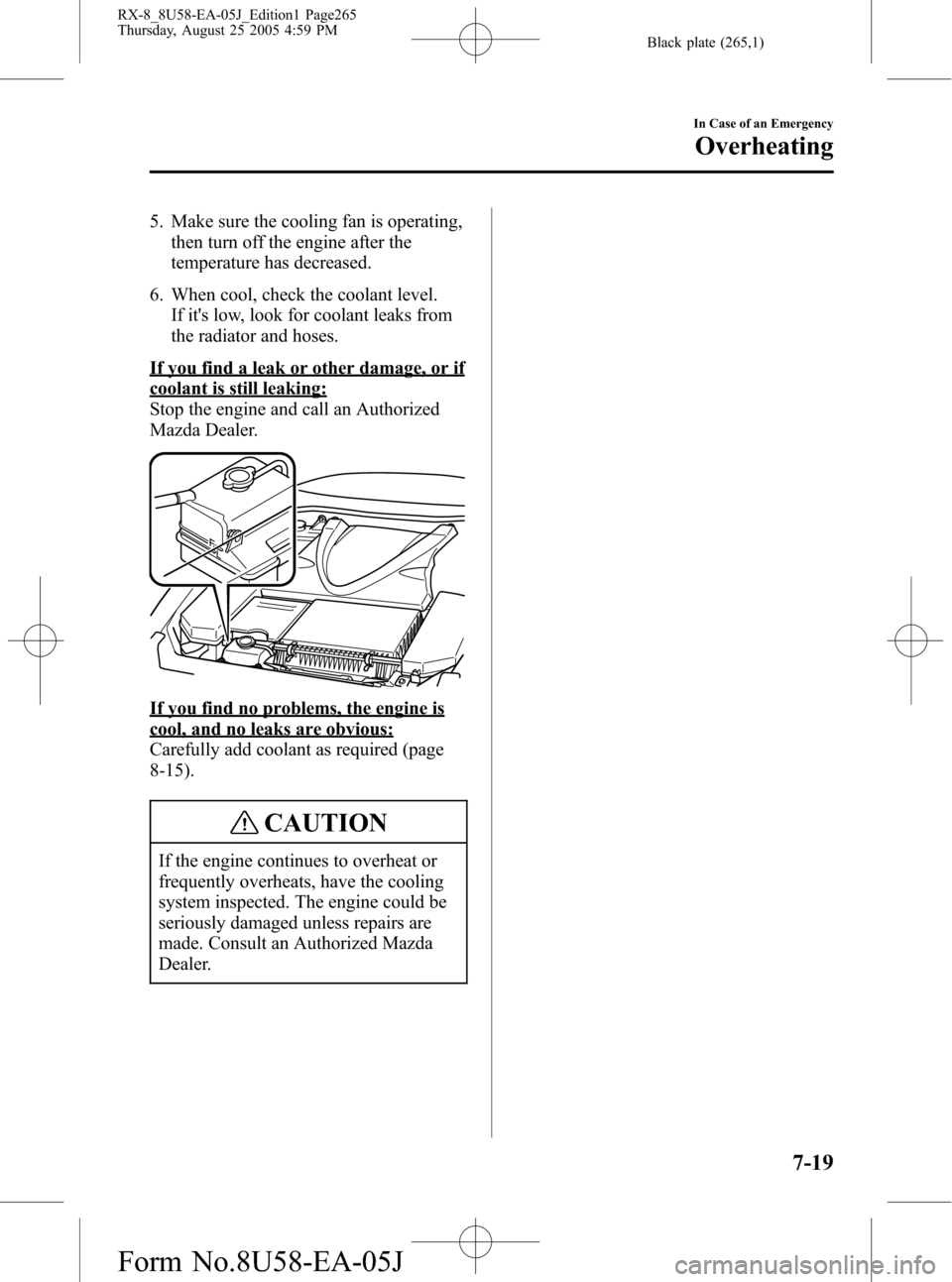
Black plate (265,1)
5. Make sure the cooling fan is operating,
then turn off the engine after the
temperature has decreased.
6. When cool, check the coolant level.
If it's low, look for coolant leaks from
the radiator and hoses.
If you find a leak or other damage, or if
coolant is still leaking:
Stop the engine and call an Authorized
Mazda Dealer.
If you find no problems, the engine is
cool, and no leaks are obvious:
Carefully add coolant as required (page
8-15).
CAUTION
If the engine continues to overheat or
frequently overheats, have the cooling
system inspected. The engine could be
seriously damaged unless repairs are
made. Consult an Authorized Mazda
Dealer.
In Case of an Emergency
Overheating
7-19
RX-8_8U58-EA-05J_Edition1 Page265
Thursday, August 25 2005 4:59 PM
Form No.8U58-EA-05J
Page 266 of 434
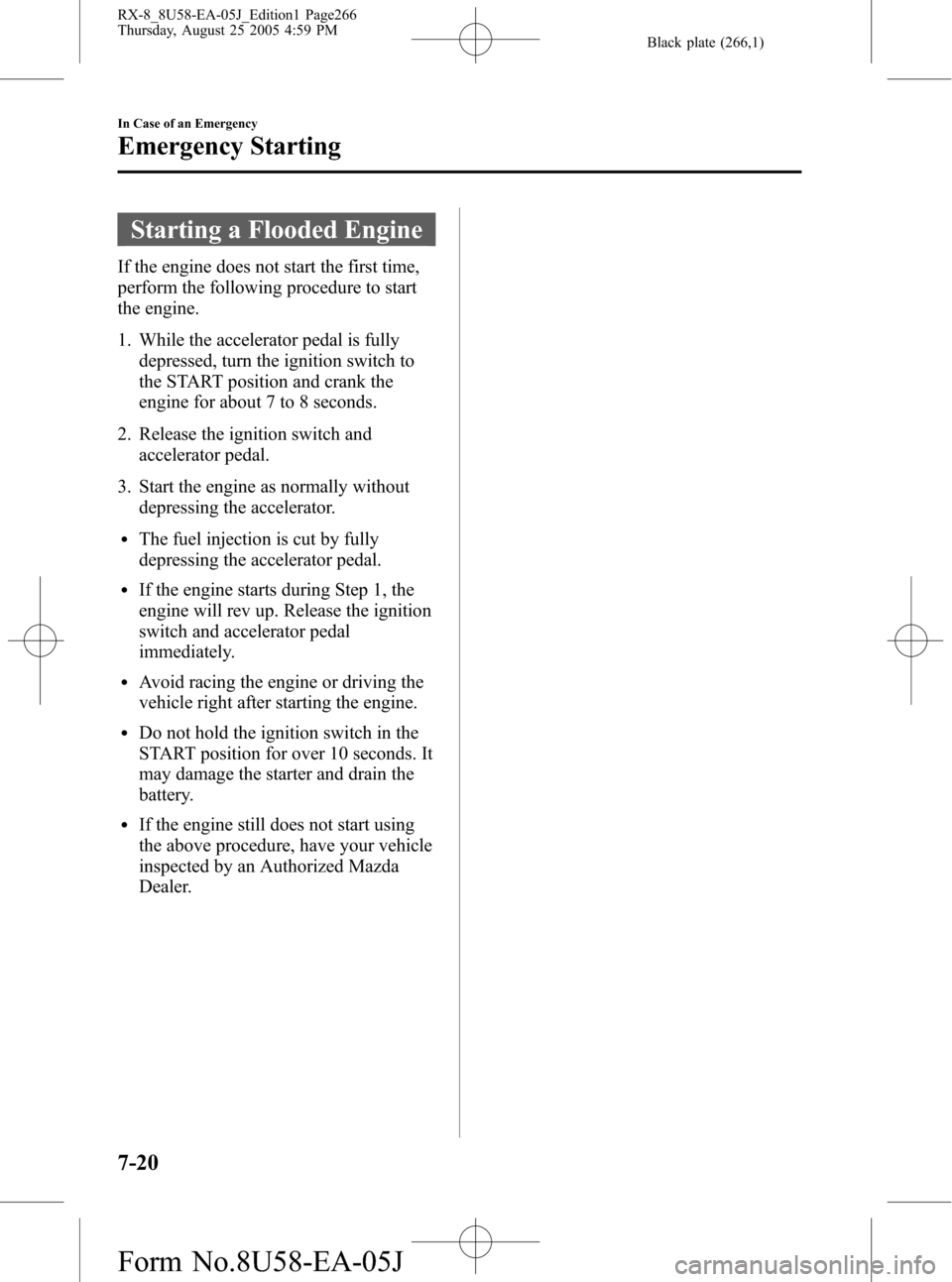
Black plate (266,1)
Starting a Flooded Engine
If the engine does not start the first time,
perform the following procedure to start
the engine.
1. While the accelerator pedal is fully
depressed, turn the ignition switch to
the START position and crank the
engine for about 7 to 8 seconds.
2. Release the ignition switch and
accelerator pedal.
3. Start the engine as normally without
depressing the accelerator.
lThe fuel injection is cut by fully
depressing the accelerator pedal.
lIf the engine starts during Step 1, the
engine will rev up. Release the ignition
switch and accelerator pedal
immediately.
lAvoid racing the engine or driving the
vehicle right after starting the engine.
lDo not hold the ignition switch in the
START position for over 10 seconds. It
may damage the starter and drain the
battery.
lIf the engine still does not start using
the above procedure, have your vehicle
inspected by an Authorized Mazda
Dealer.
7-20
In Case of an Emergency
Emergency Starting
RX-8_8U58-EA-05J_Edition1 Page266
Thursday, August 25 2005 4:59 PM
Form No.8U58-EA-05J
Page 268 of 434

Black plate (268,1)
WARNING
Keep Flames Away:
Flames and sparks near open battery cells are dangerous. Hydrogen gas, produced
during normal battery operation, could ignite and cause the battery to explode. An
exploding battery can cause serious burns and injuries. Keep all flames including
cigarettes and sparks away from open battery cells. When working near a battery, do
not allow metal tools to contact the positive (
) or negative () terminal of the
battery. Do not allow the positive (
) terminal to contact any other metal object that
could cause sparks.
Battery-Related Explosion:
Flames and sparks near open battery cells are dangerous. Hydrogen gas, produced
during normal battery operation, could ignite and cause the battery to explode. An
exploding battery can cause serious burns and injuries. Keep all flames, including
cigarettes, and sparks away from open battery cells.
Low Fluid Level or Frozen Battery:
Jump-starting a frozen battery or one with a low fluid level is dangerous. It may
rupture or explode, causing serious injury.
Don't jump-start a frozen battery or one with a low fluid level.
Connecting Jumper Cable Directly to Negative Terminal:
Connecting the end of the second jumper cable to the negative (
) terminal of the
discharged battery is dangerous.
A spark could cause the gas around the battery to explode and injure someone.
Connect the negative cable to a good ground point away from the battery.
Connecting Jumper Cable to Moving Parts:
Connecting a jumper cable near or to moving parts (cooling fans, belts) is dangerous.
The cable could get caught when the engine starts and cause serious injury. Route the
jumper cables away from parts that will be moving.
CAUTION
Use only a 12 V booster system. You can damage a 12 V starter, ignition system, and
other electrical parts beyond repair with a 24 V power supply (two 12 V batteries in
series or a 24 V motor generator set).
7-22
In Case of an Emergency
Emergency Starting
RX-8_8U58-EA-05J_Edition1 Page268
Thursday, August 25 2005 4:59 PM
Form No.8U58-EA-05J
Page 269 of 434

Black plate (269,1)
1. Remove the engine cover.
2. Remove the rubber hose from the
battery cover.
3. Remove the battery cover from its rear
side.
4. Make sure the booster battery is 12 V
and that its negative terminal is
grounded.
5. If the booster battery is in another
vehicle, don't allow the vehicles to
touch. Turn off the engine of the
vehicle with the booster battery and all
unnecessary electrical loads in both
vehicles.
6. Connect the jumper cables in the exact
sequence as in the illustration.
lConnect one end of a cable to the
positive terminal on the discharged
battery (1).
lAttach the other end to the positive
terminal on the booster battery (2).
lConnect one end of the other cable
to the negative terminal of the
booster battery (3).
lConnect the other end to a solid,
stationary, exposed metallic point
(for example, the tightening bolt)
away from the discharged battery
(4).
Booster battery
Connect cables
in numerical
order and
disconnect in
reverse order.
Discharged
battery
7. Start the engine of the booster vehicle
and run it a few minutes. Then start the
engine of the other vehicle.
In Case of an Emergency
Emergency Starting
7-23
RX-8_8U58-EA-05J_Edition1 Page269
Thursday, August 25 2005 4:59 PM
Form No.8U58-EA-05J
Page 270 of 434
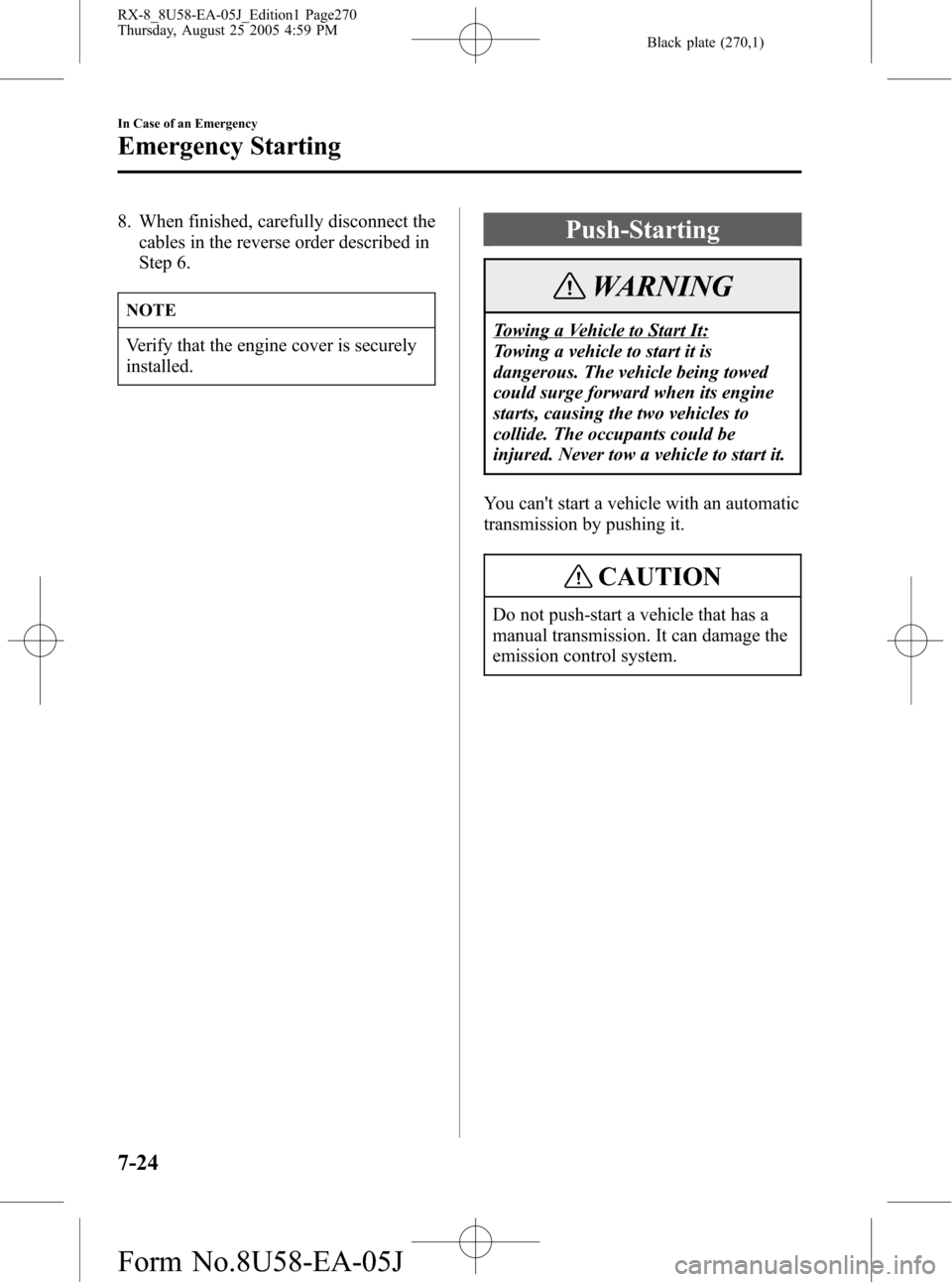
Black plate (270,1)
8. When finished, carefully disconnect the
cables in the reverse order described in
Step 6.
NOTE
Verify that the engine cover is securely
installed.
Push-Starting
WARNING
Towing a Vehicle to Start It:
Towing a vehicle to start it is
dangerous. The vehicle being towed
could surge forward when its engine
starts, causing the two vehicles to
collide. The occupants could be
injured. Never tow a vehicle to start it.
You can't start a vehicle with an automatic
transmission by pushing it.
CAUTION
Do not push-start a vehicle that has a
manual transmission. It can damage the
emission control system.
7-24
In Case of an Emergency
Emergency Starting
RX-8_8U58-EA-05J_Edition1 Page270
Thursday, August 25 2005 4:59 PM
Form No.8U58-EA-05J
Page 275 of 434

Black plate (275,1)
8Maintenance and Care
How to keep your Mazda in top condition.
Introduction .................................................................................. 8-2
Introduction ............................................................................... 8-2
Scheduled Maintenance ................................................................ 8-3
Scheduled Maintenance ............................................................ 8-3
Owner Maintenance ..................................................................... 8-8
Owner Maintenance Schedule .................................................. 8-8
Owner Maintenance Precautions ............................................... 8-9
Engine Compartment Overview .............................................. 8-11
Engine Oil ............................................................................... 8-12
Engine Coolant ....................................................................... 8-15
Brake/Clutch Fluid .................................................................. 8-18
Washer Fluid ........................................................................... 8-19
Body Lubrication .................................................................... 8-20
Air Filter .................................................................................. 8-21
Wiper Blades ........................................................................... 8-22
Battery ..................................................................................... 8-24
Tires ........................................................................................ 8-27
Light Bulbs ............................................................................. 8-32
Fuses ....................................................................................... 8-39
Appearance Care ........................................................................ 8-44
How to Minimize Environmental Paint Damage .................... 8-44
Exterior Care ........................................................................... 8-46
Interior Care ............................................................................ 8-49
8-1
RX-8_8U58-EA-05J_Edition1 Page275
Thursday, August 25 2005 4:59 PM
Form No.8U58-EA-05J
Page 278 of 434
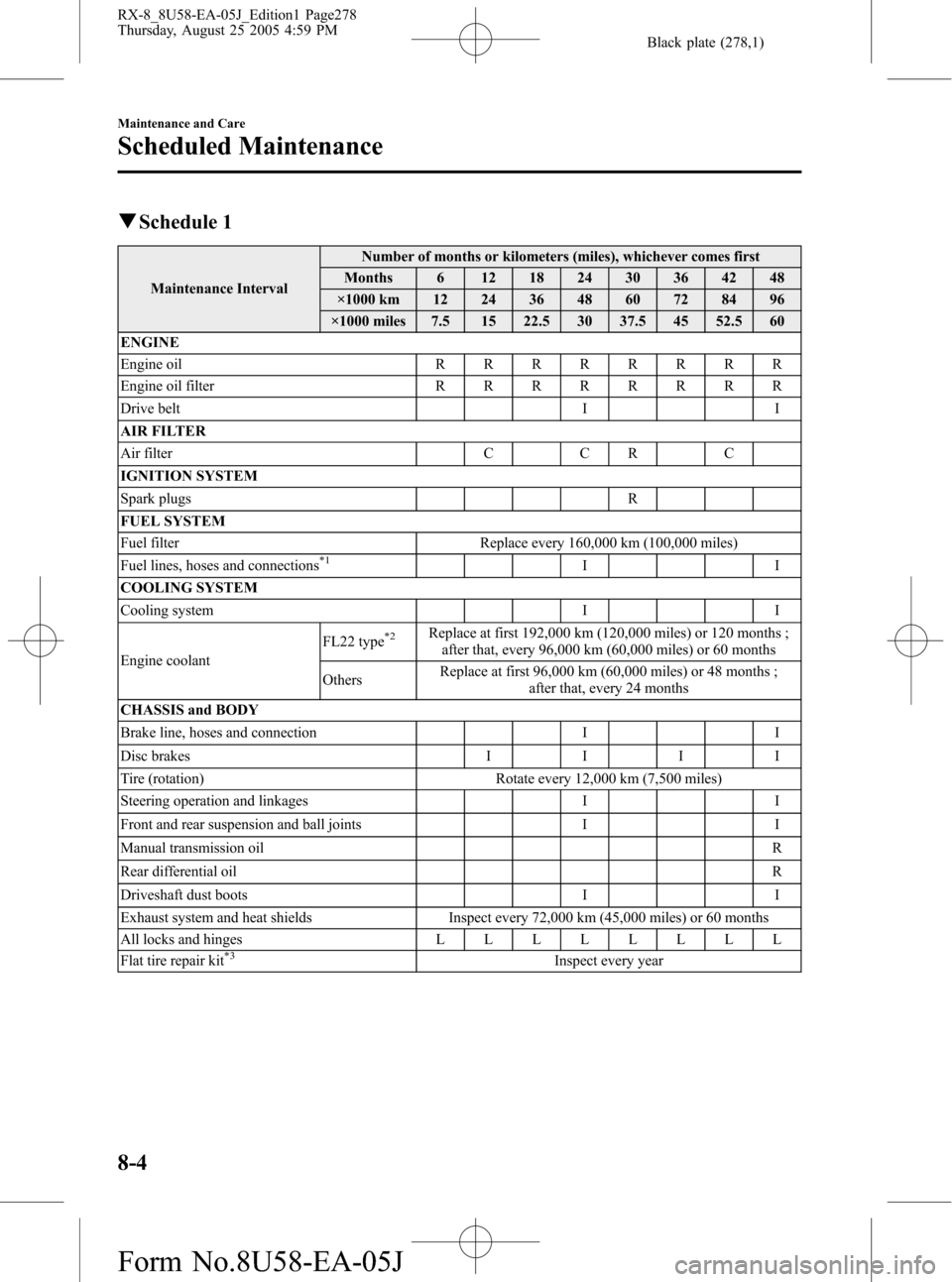
Black plate (278,1)
qSchedule 1
Maintenance IntervalNumber of months or kilometers (miles), whichever comes first
Months 6 12 18 24 30 36 42 48
×1000 km 12 24 36 48 60 72 84 96
×1000 miles 7.5 15 22.5 30 37.5 45 52.5 60
ENGINE
Engine oilRRRRRRRR
Engine oil filterRRRRRRRR
Drive belt I I
AIR FILTER
Air filter C C R C
IGNITION SYSTEM
Spark plugs R
FUEL SYSTEM
Fuel filter Replace every 160,000 km (100,000 miles)
Fuel lines, hoses and connections
*1II
COOLING SYSTEM
Cooling system I I
Engine coolantFL22 type
*2Replace at first 192,000 km (120,000 miles) or 120 months ;
after that, every 96,000 km (60,000 miles) or 60 months
OthersReplace at first 96,000 km (60,000 miles) or 48 months ;
after that, every 24 months
CHASSIS and BODY
Brake line, hoses and connection I I
Disc brakesIIII
Tire (rotation) Rotate every 12,000 km (7,500 miles)
Steering operation and linkages I I
Front and rear suspension and ball joints I I
Manual transmission oilR
Rear differential oilR
Driveshaft dust boots I I
Exhaust system and heat shields Inspect every 72,000 km (45,000 miles) or 60 months
All locks and hingesLLLLLLLL
Flat tire repair kit
*3Inspect every year
8-4
Maintenance and Care
Scheduled Maintenance
RX-8_8U58-EA-05J_Edition1 Page278
Thursday, August 25 2005 4:59 PM
Form No.8U58-EA-05J
Page 280 of 434

Black plate (280,1)
qSchedule 2
Maintenance IntervalNumber of months or kilometers (miles), whichever comes first
Months 4 8 12 16 20 24 28 32 36 40 44 48
×1000 km 8 16 24 32 40 48 56 64 72 80 88 96
×1000 miles 5 10 15 20 25 30 35 40 45 50 55 60
ENGINE
Engine oilPuerto Rico Replace every 5,000 km (3,000 miles) or 3 months
OthersRRRRRRRRRRRR
Engine oil filterRRRRRRRRRRRR
Drive belt I I
AIR FILTER
Air filter C C R C
IGNITION SYSTEM
Spark plugs R
FUEL SYSTEM
Fuel filter Replace every 160,000 km (100,000 miles)
Fuel lines, hoses and connections
*1II
COOLING SYSTEM
Cooling system I I
Engine coolantFL22 type
*2Replace at first 192,000 km (120,000 miles) or 120 months ;
after that, every 96,000 km (60,000 miles) or 60 months
OthersReplace at first 96,000 km (60,000 miles) or 48 months ;
after that, every 24 months
Engine coolant levelIIIIIIIIIIII
ELECTRICAL SYSTEM
Function of all lightsIIIIIIIIIIII
8-6
Maintenance and Care
Scheduled Maintenance
RX-8_8U58-EA-05J_Edition1 Page280
Thursday, August 25 2005 4:59 PM
Form No.8U58-EA-05J
Page 282 of 434
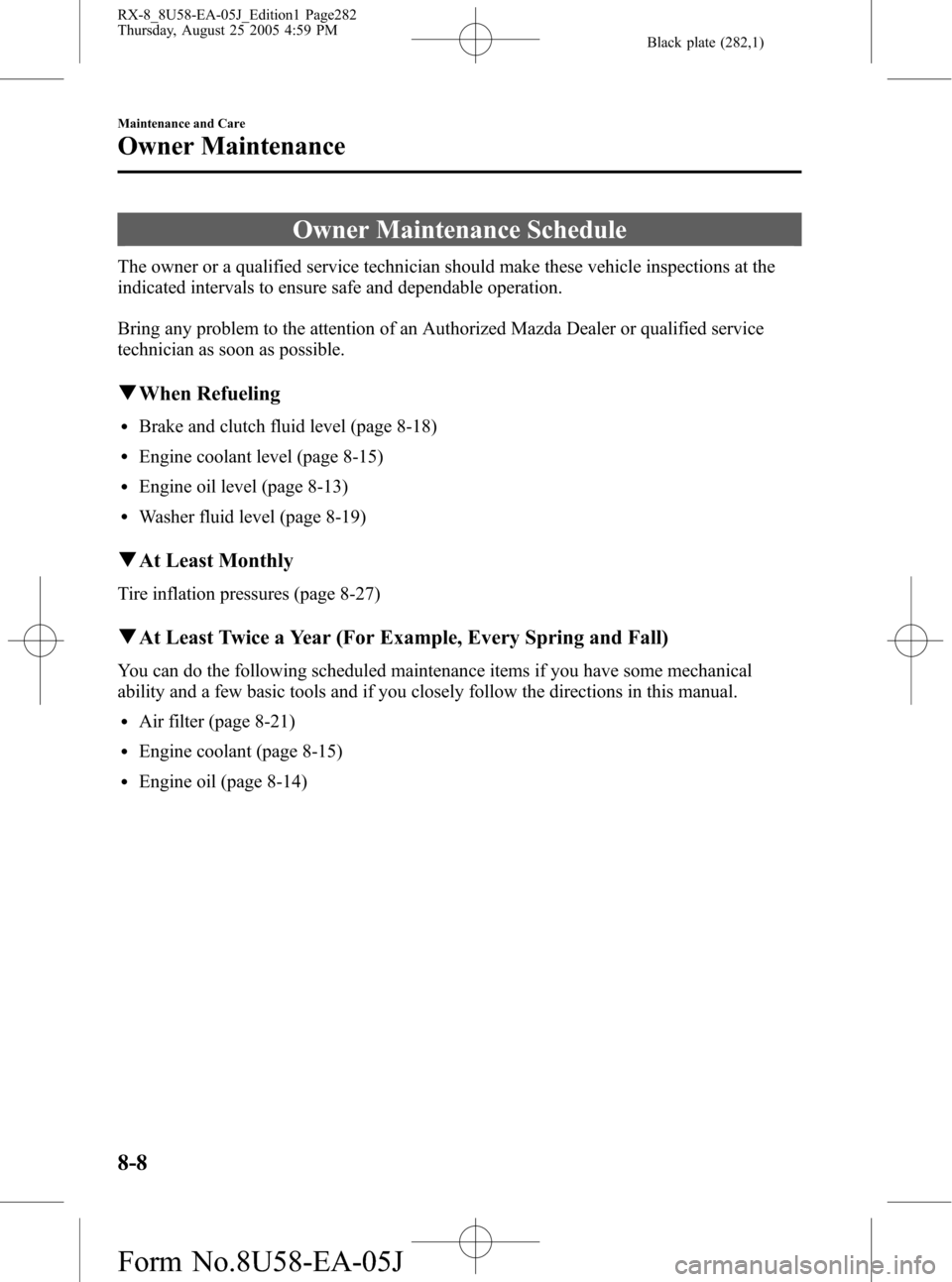
Black plate (282,1)
Owner Maintenance Schedule
The owner or a qualified service technician should make these vehicle inspections at the
indicated intervals to ensure safe and dependable operation.
Bring any problem to the attention of an Authorized Mazda Dealer or qualified service
technician as soon as possible.
qWhen Refueling
lBrake and clutch fluid level (page 8-18)
lEngine coolant level (page 8-15)
lEngine oil level (page 8-13)
lWasher fluid level (page 8-19)
qAt Least Monthly
Tire inflation pressures (page 8-27)
qAt Least Twice a Year (For Example, Every Spring and Fall)
You can do the following scheduled maintenance items if you have some mechanical
ability and a few basic tools and if you closely follow the directions in this manual.
lAir filter (page 8-21)
lEngine coolant (page 8-15)
lEngine oil (page 8-14)
8-8
Maintenance and Care
Owner Maintenance
RX-8_8U58-EA-05J_Edition1 Page282
Thursday, August 25 2005 4:59 PM
Form No.8U58-EA-05J